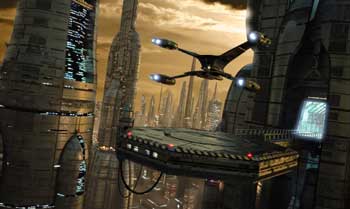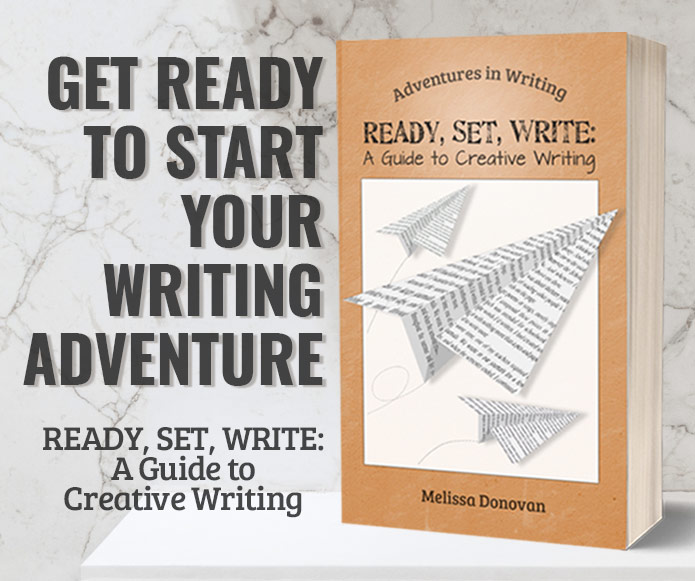Please welcome Sarah Kolb-Williams with a guest post on writing a science-fiction novel.
Writing a science-fiction novel isn’t all rockets and robots—it’s a brainy labor of love, and it takes a good deal of time and attention to detail to get it right. Here’s how to emerge from the process still standing:
1. Think, Then Think Harder
Science-fiction fans are sticklers for cold, hard science. That’s why so many of them are exclusively sci-fi readers—other genres just don’t give up the goods. Get the science right, and earn the readers’ respect. Wing it, and prepare to be heckled out of the building.
Really look at what you’re doing, and remember, written science fiction is held to much more stringent standards than the genre’s onscreen counterpart. We give television some leeway because we understand a studio’s budgetary concerns, but if you start writing about crew members bouncing around their spaceship with nary a mention of gravity or landing on other planets and just flinging the doors open and breathing, we’re going to have words.
2. Outline
Science fiction isn’t like other genres; you can’t just blink your eyes and create an entire world. You have to understand the rules of your environment perfectly, because if you don’t, you’ll inevitably contradict yourself. And if there’s one thing readers hate in any genre and in science fiction in particular, it’s a book that contradicts itself.
If you want to present readers with a living, breathing place, give enough detail to really show it to them—especially with regards to the technological infrastructure. You don’t need to include every detailed description and scribbled drawing in your book, but you do need to understand those details yourself so you can insert the right detail for the right moment.
If you don’t put any thought into your science, readers will know, and they will laugh at you. You’ve been warned.
3. Create Characters
Too often, aspiring science-fiction writers get so wrapped up in the intricacies of the world they’ve created that they forget about the actual people who live in it—so they plop down Strong Female Character or Heroic Male Lead or Helpless Love Interest, who are obviously present only to facilitate the lavish descriptions of the premise.
Stories don’t happen to settings; they happen to characters. The societal and technological structure of your world may be captivating, but if we’re not seeing it through your characters’ eyes, if we’re not smelling the garbage and feeling the cold steel, it’s just a bunch of pretty words.
4. Write the Darn Thing
“I have this really cool idea for a science fiction novel…”
Okay, so what? Write it out and see if it works. Turn it over in your mind, sit on it for years if you like, but at some point, you need to actually get the thing out of your head and onto paper or screen.
Here’s the secret to letting go of your fear that your first draft will be terrible: accept that it will be terrible.
There will be plot holes. Characters will do uncharacteristic things. It will be more than rough around the edges, and you’re not going to want to show it to anyone, ever.
Well, guess what? It’s called the first draft for a reason; you don’t have to show it to anyone. Ever. Just vomit it out until it’s out—you can’t work with it if it doesn’t exist.
5. Forget About It
Once you have a nice, heaping pile of manuscript to show for all your hard work, it’s finally time . . . to chuck it in a drawer and forget about it for a month.
I’m not kidding. The human brain is not a computer—not in this timeline anyway—and it starts to tweak out (that’s a technical term) after focusing on something over and over and over. The only way you can possibly look at the manuscript with anything resembling objectivity is to distance yourself from it and then pretend it’s someone else’s, and the only way to do that is to get the thing off your mind for a while.
Give it at least two weeks, or even better, a month.
6. Rewrite, Rewrite, Rewrite
The second draft is where the magic happens. This is what forcing yourself through the first draft was all about. By the time you get to the end, you know your characters—who they are, how they act, how they relate to each other. The same goes for the science in your story—by the end, your understanding of the world you’ve created has solidified even more. Now is your chance to go back and update places you didn’t quite produce the right chemistry or give the right impression.
And just as importantly, after you’ve put some distance between your eyes and the manuscript, you can come back to it with a renewed sensitivity to what your book actually is.
Are there any themes that you can sharpen with a few well-placed scenes? Did anything interesting emerge that you hadn’t intended? Beneath that rambling first draft lies your novel, and during this stage, you’ll mold the manuscript into something stronger.
7. Send It to Beta Readers
Even after your heroic efforts to pretend you’ve never read the story you have in fact written, the only way to really find out what someone else might think of your book is—no surprise here—to ask them.
Gather a small group of friends—not the ones who let you walk around with spinach in your teeth without telling you—the ones who tell you honestly when you probably shouldn’t wear something in public, and ask them to read your manuscript with a critical eye.
Make sure to help them out by giving them a bit of direction. Ask them to give you specific feedback on areas you’re unclear of yourself; ask them to tell you if someone’s acting out of character, if your science is bogus—anything. Just make sure they understand that you’re looking for real feedback, not just an affirmation of your greatness.
8. Decide on Your Publishing Path
There are two main ways to publish a science fiction novel: find a traditional publisher or go the self-publishing route.
If you plan to pursue traditional publishing, your best bet for getting in the door is through an agent. Do your research. Make sure you select an agent who actually represents science fiction (not all do); accepted genres should be listed in the agents’ submission guidelines.
And be extra careful to follow the submission guidelines to the letter. Some of the requirements may seem picky—so what if your margins are a bit outside the norm?—but here’s another secret: agents receive far too many pitches to even hope to read them all, and chucking out anything that doesn’t conform to preferred specs is one effective, if excessive, way to cull submissions down to a manageable size.
And if you’re self-publishing, brace yourself: this is where the money part comes in. Certainly you should cut all the corners you can—that’s the indie way!—but without a professional cover, your book is DOA . . . and without being copyedited, anyone who does make it past your cover will find a typo-ridden interior and justly hurl your book across the room.
Ask around, find a good editor (one who has actually worked on science fiction would be ideal), and shell out. You owe it to yourself and to anyone who hands over their hard-earned money for your book with certain expectations of quality. (Even if you do plan to traditionally publish, consider hiring an editor on your own to help polish your manuscript until it shines so agents can see its full potential.)
9. Sell the Heck Out of It!
It’s finally time. If you’re self-publishing, figure out your print and e-book distribution. And for frak’s sake, get yourself a professional website already.
And traditional publisher or no, you’ll be primarily responsible for putting yourself out there. Make nice with the sci-fi bloggers, carve out a space for yourself on social media, and keep pushing your book (without being a jerk about it, please).
It’s important to keep publication expectations realistic. If initial sales aren’t what you may have hoped, don’t get discouraged—in such a crowded marketplace, it’s difficult for a brand new author to get noticed.
Now quit whining and get started on book two—you’ll have a leg up this time because you’ll no longer be a rookie author!
About the Author: Sarah Kolb-Williams is a writer, editor, and serial comma enthusiast from the Twin Cities. Find her here on Google Plus or on Twitter: @skolbwilliams





Very helpful suggestions and, as a self-published author (“Bessie Howard; Virtual Sorceress” via Amazon), I struggled through some of them. If not for the capable (and merciless) editorial skills of wife Ruthie, and also our professional editor, Rob Bignell (noted in the novel’s intro), there would have been no book.
Currently writing the sequel, I’ll take your comments more to heart. All the best, Gib Check